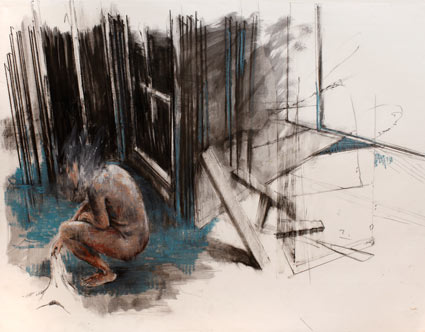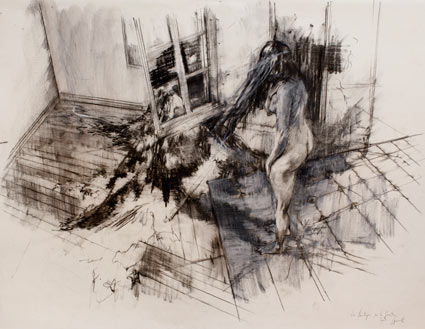Julien Spianti
The Face of the Place
While the modern painting, since Bacon at least, has made a sort of figurative leitmotif of the destruction of face and body, the work of Julien Spianti, in almost musical contrast, adds to that pathetic representation of the body its spatial correlation: What if the place, as it was in medieval aesthetics, becomes the locus translativus that Albert the Great spoke of; in other words, a face-place space that enable the complexity of the state of the soul to enters the world of pure visibility.
The face of the place
"The space has something to say that the body does not. If the faces fade, it's because there is a face of the place, of the surroundings-- a face of the room."
The room is a monad—a complete unit— or rather, the confined space of a soul outside of which is woman, nymph, dyad. Ecce ninfa. The woman is the fantasy that comes to turn the room into the sensitive space of a body, a skin, an energy field, capable of giving shape to the psychological procrastination of a soul. Yes, the place has no hysteria without the woman. That is the truth that emerges from this series of drawings: the woman creates the outside of the monad, even if this outside is nothing but a fantasy or projection. The woman's presence in the room enables the viewer to conjure the monad's aura.
“The woman’s purpose in the space is to modify the structure and male geometry of it. She transforms it into a troubled space, a space that liquefies, that expands.”

“The symptom is an unconscious fantasy, translated in motor language, projected on motivity, represented by the pantomime.”Sigmund Freud

But who is this woman capable of transforming the space and determining the extent of its metamorphosis? Could she be the secular image of the ninfa— the woman-child whose figurative evolution the historian Aby Warburg incessantly kept track of ? This is more than likely, especially since each of Spianti’s pieces deploys multiple art history references (it would, on another note, be interesting to examine in detail the presence of the paintings on the walls of the room). Further, in Spianti's pieces one can notice particular attention paid to referencing the history of forms seen in the ninfa (or Gradiva)—the archetype of the signa translata, the sign that destabilizes the closed space of representation from the inside out.
“There is an interplay and constant reflections between the figure and her inner world, her room, the place that also derives from a prison structure.”
So there, between the woman and the imprisoning space of the room, a sort of virtual game is implied, forcing the viewer to dive into the polysemy of the images without abandoning the idea of giving them a meaning. And as Fra Angelico painted a paradise under the guise of a bloody garden, Julien Spianti offers us a renewed iconography of The Fall—a torture chamber?—beneath which, perhaps, is a world to which the woman holds the key.
Frédéric-Charles Baitinger
Julien Spianti is a french artist who lives and works in Paris and Bruxelles
julienspianti.comGalerie Pierre Marie Vitoux
Le syndrome de Stendhal
du 11 Février 2010 au 13 Mars 2010
3 rue d'Ormesson, Place Sainte Catherine, Métro Saint Paul, ligne 1
www.galeriepierremarievitoux.com
